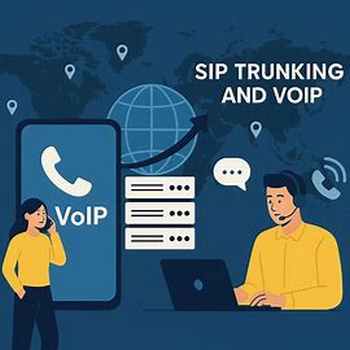VoIP and SIP trunking.
Ah yes, the telecom industry’s favorite roots-versus-branches debate. Pull up a chair, and let’s cut through the noise.
SIP trunking and VoIP. On the surface, they’re cousins at a telecom family reunion, each claiming to have invented the future of phone calls. 📞
VoIP (Voice over Internet Protocol) is the digital equivalent of throwing your old copper lines out the window. With VoIP, your voice packs its bags, hops into data packets, and cruises across the web.
It’s instant, app-driven, and straightforward—like using FaceTime or WhatsApp to call your mum, but with better hold music. ☁️ I’ve seen an intern set up VoIP in under half an hour, and that same intern once tried to microwave a stapler, so yes, it’s user-friendly. 🥲
SIP trunking is for offices where the break room fridge is covered in PBX manuals and someone’s always talking about “redundancy.”
SIP Versus VoIP
While VoIP is the umbrella technology—voice calls galloping merrily over the internet—SIP trunking is the supply chain. It’s let loose the ability to scale, to handle multiple communications channels, and to wrangle existing phone systems into behaving like modern software.
You want basic calls? Go VoIP and enjoy your plug-and-play life. You want control, global presence, and low per-call rates for 200 employees who all apparently need their own direct lines? Welcome to the world of SIP trunking, lad.
🗄️ It’s a method for connecting your business’s heavy-duty phone system (PBX) to the outside world, using the SIP protocol and virtual channels instead of physical wires. Imagine your entire call center folding into the cloud, with every extension able to ring in Tokyo or Tijuana without a hitch.
🌏 It’s more technical, and if you’re the type who brags about firewall rules at lunch, you’ll love it.
One time, I watched an office manager who thought VoIP was “just plug and play” try to route calls globally…with no SIP trunk! Calls ended up lost in cyberspace, much like my coffee mug after company renovations.
🥤 Eventually, SIP trunking patched the gap, and suddenly those calls landed reliably wherever they were dialed. 🎯
To sum up:
- VoIP: Great for small teams, easy setup. Just install, dial, and talk. No PBX required. 👩💻
- SIP trunking: Best for scaling up, PBX integration, and controlling lots of lines across the globe. Technical setup, endless flexibility. 🛠️🌐
If you want convenience, go VoIP. If you want to rule the phone system like a benevolent dictator—and never again lose a coffee mug in the ether—embrace SIP trunking. 😏
Obtain extra phone numbers, optionally.
It’s not strictly required, but… if you’re adopting SIP trunking, chances are you will need to think about phone numbers in a slightly new way. Here’s the deal:
SIP trunking itself is a service that lets your phone system connect to the outside world over the internet instead of traditional phone lines. It doesn’t inherently demand new phone numbers, but here’s what usually happens in practice:
- You can keep your existing phone numbers by porting them over from your current carrier to your SIP trunk provider. This means the same familiar numbers your customers and colleagues use will work seamlessly after the switch. 📞
- Alternatively, you might choose (or need) to acquire new numbers from your SIP provider, especially if you’re expanding into new geographic markets or need direct inward dial (DID) numbers for different departments or employees. 🌍
- SIP trunking supports many types of numbers: local, toll-free, virtual, and international. These give businesses flexibility and presence without needing physical locations. 🏢
- If your PBX setup uses DIDs (Direct Inward Dial numbers—which is common), those are typically assigned per channel or extension and are part of the SIP trunking phone number management ecosystem.
In simple terms: You don’t have to buy new numbers just because you start SIP trunking. But for growth, geographical coverage, or organizational needs, it often makes sense to add them. Your SIP provider usually helps manage number porting, provisioning, and flexibility. 📲
So, SIP trunking doesn’t force you into getting more phone numbers, but it opens the door to that possibility with more ease and options than old traditional phone lines ever did.
Learn more about adding more phone numbers, even international numbers here.



